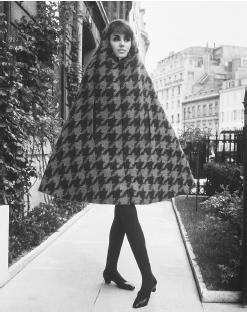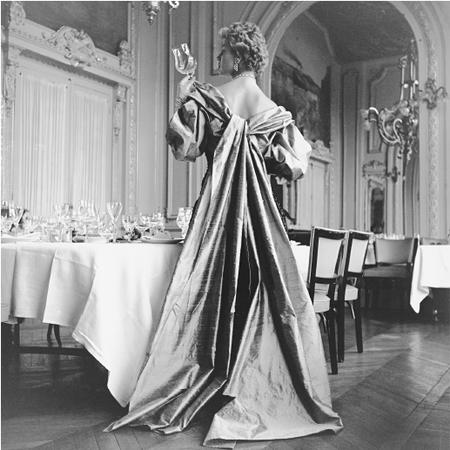Jacques Heim - Fashion Designer Encyclopedia
French designer
Born: Paris, 8 May 1899. Family: Married; one son: Philippe. Career: Manager, Isadore and Jeanne Heim fur fashion house, from about 1920; initiated couture department for coats, suits, and gowns, circa 1925; opened own couture house, 1930; Heim Jeunes Filles collection introduced, 1936; Heim sportswear boutiques established in Biarritz and Cannes, from 1937; Heim-Actualité girlswear collection introduced, 1950; fragrances included Alambie, 1947, J'Aime, 1958, Shandoah, 1966; house closed, 1969; president, Chambre Syndicale de la Couture Parisienne, 1958-62. Also owner and publisher, Revue Heim, 1950s. Died: 8 January 1967, in Paris.
Publications
On HEIM:
Books
Milbank, Caroline Rennolds, Couture: The Great Designers, NewYork, 1985.
Stegemeyer, Anne, Who's Who in Fashion, Third Edition, New York,1996.

Articles
Peterson, Patricia, "Heim Drops Hemline and Ban on Photographs," in the New York Times, 23 July 1962.
Obituary, in the New York Times, 9 January 1967.
***
Caroline Rennolds Milbank called Jacques Heim an "innovator by nature," in her 1985 book, Couture: The Great Designers . Few would agree. Heim's New York Times obituary (9 January 1967) read: "Mr. Heim's fashion house designed and made clothes of a modest style. He was never in the front ranks of the big houses that radically changed the looks of women by offering new silhouettes in the manner of Balenciaga, Chanel, or Saint Laurent." Perhaps the median truth was expressed in Women's Wear Daily 's obituary: "Heim was basically an innovator in business. He didn't want to be called a designer, but rather an editor of clothes." He aggressively conceived of ways in which couture might be vital to new audiences (his Heim Jeunes Filles brought garments to a young audience long before other couture designers, and engendered early client loyalty) and was an impeccable spokesman for the fashion industry of France (until he broke with the couture schedule for delayed photographs in summer 1962). He was an editor of many design ideas, beginning with the possibilities of fur, continuing through beach and play outfits, even the two-piece swimsuit, and the plane and planar simplifications of design in the youth-conscious 1960s.
If he was not driven by the market, he was at least keenly sensitive to it. Heim was a smart, eclectic designer of many styles; through consistent sales sensitivity he transformed the fur business of his parents Isadore and Jeanne Heim, founded in 1898, and persevered and prospered as a designer for nearly four decades. Heim's fashion breakthrough was to realize that fur could be worked as a fabric. Wool and fur combinations, geometries of fur and textiles, and fur accents became hallmarks of the Heim fashion in the 1930s. At the same time, along with Chanel and Patou and others, Heim was alert to the possibilities of elegant sportswear and observed bathing and sports costumes as inspiration. According to Milbank, Heim was inspired by the Tahitian exhibits in the Paris colonial exhibition of 1931 to create pareos and sarongs. Later, his 1950 two-piece swimsuit Atome came considerably after the bikini incident and invention, but addressed a broader public.
Through the 1950s, Heim addressed American needs for sportswear in innovative and utilitarian fabrics, while still remaining, in the vocabulary of the day, very ladylike. Moreover, his Heim Actualité diffusion line, launched in 1950, extended his influence into ready-to-wear along with the young styles of Heim Jeunes Filles. From 1958 to 1962 he was president of the Chambre Syndicale de la Couture Parisienne, and was "probably the last effective president of the couture's professional body," according to Women's Wear Daily. When, however, he permitted immediate release of collection photographs to the press in July 1962, in advance of the agreed-upon delayed release, he precipitated a furor among designers to preserve the design's secret until their slow dissemination. Heim was steadfastly modern and business-oriented. In this decision, he anticipated the couture's gradual détente in the 1960s, but did it so abruptly that he lost the confidence of his colleagues. Patricia Peterson, writing for the New York Times, in July 1962, reported, "Photographs were not to have been published in the United States until August 26, for Europe the release date was to have been August 27. When Heim allowed

Favored by Mme. Charles de Gaulle and a designer for Mrs. Dwight D. Eisenhower, Heim understood the expression "old soldiers never die." He never married a style or became one form's advocate; instead, he had insisted on the business principle that fashion would thrive in change and adaptation. "The life of a couturier is a magnificent and continuous torture," Heim said. But he was probably only expressing a businessman's shrewd romanticism and a leader's quixotic belief in fashion's anguish. His commerce was clearly his passion and his métier, not the design itself. As the New York Times commented in his obituary, "Jacques Heim, a tall good-looking man with a cheery disposition, seemed more like a businessman or banker than a couturier. He exhibited none of the flamboyance or temperament of competitors like Yves Saint Laurent or Christian Dior." But, of course, design is made by acumen as well as by inspiration.
—Richard Martin
Comment about this article, ask questions, or add new information about this topic: